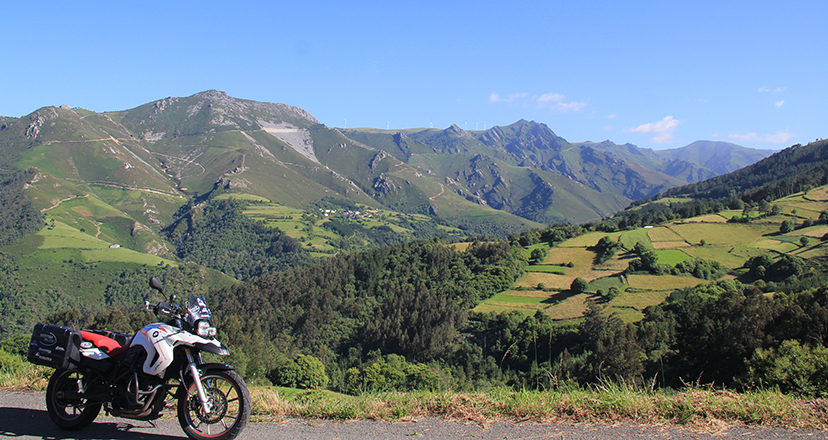Atrás Disfruta en moto de los miradores más fascinantes alrededor de Picos de Europa

Disfruta en moto de los miradores más fascinantes alrededor de Picos de Europa
Un recorrido en moto por los miradores del Oriente de Asturias que dan a los Picos de Europa te dejará fascinado con los paisajes de esta comarca.
Tan solo 6 kilómetros separan Colunga de Santiago de Gobiendes, lugar en el que comenzaremos esta aventura llena de escenarios espectaculares y donde cualquier turista hallará mil y una razones no sólo para enamorarse de Asturias sino también para regresar. Visitaremos aquí su iglesia, joya del prerrománico asturiano declarada, el 3 de Junio de 1.931, Monumento Histórico Artístico. Con una planta inscrita en un rectángulo con tres cabeceras de cuatro tramos, un triple nártex y dos compartimentos a los lados del primer tramo de las naves es, junto con el Centro de Interpretación de la Sierra del Sueve, muy próximo a ella, visita obligada.
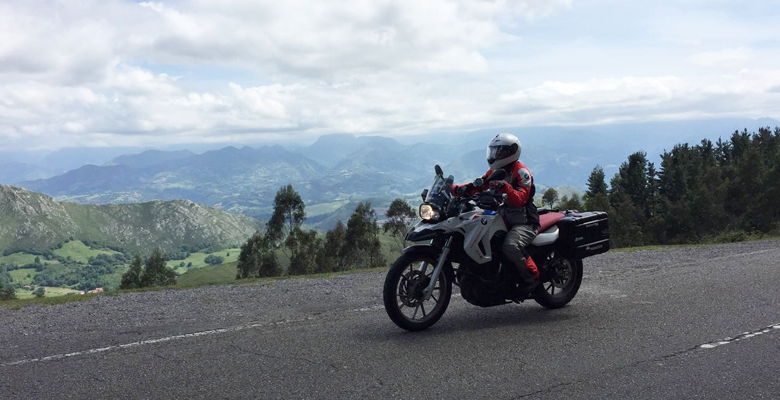
Desde aquí, ascenderemos por la AS-260 hasta el primero de los miradores que visitaremos y, posiblemente, el más conocido y transitado. Pocas descripciones más necesitas para saber que estamos hablando del mirador de El Fitu, un enclave al que le sobran razones para ocupar la primera posición de este ranking.
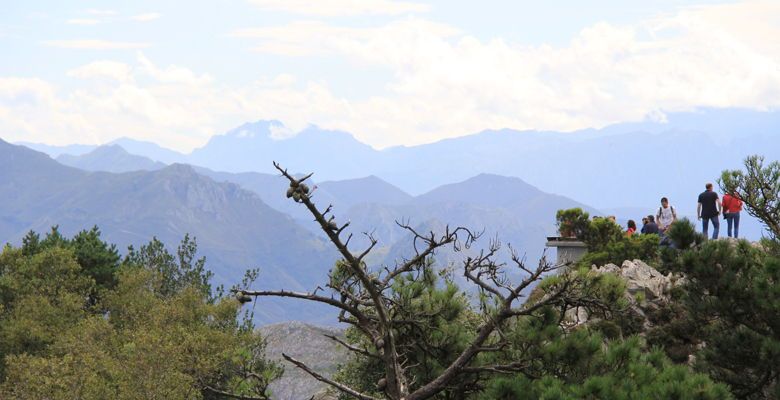
Desde él, mar y montaña son todo uno. La combinación perfecta de dos elementos que huyen del aburrimiento y atraen dinamismo y diversión. Llama la atención su apariencia de platillo volante o ‘cazu’ – como la conocen los lugareños, una estructura que parece diseñada para elevarse sobre el suelo y sobrevolar los árboles ofreciendo así la mejor panorámica de la zona. En días despejados, gozaremos de unas vistas privilegiadas de Picos de Europa pero, no hay que olvidar, que son frecuentes las nieblas, fenómeno meteorológico que parece que ha sabido resguardar a esta Sierra (la del Sueve) del paso del tiempo.
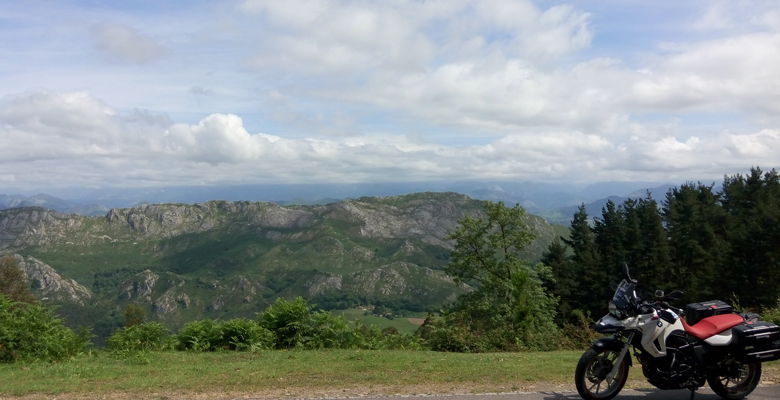
Ya en Arriondas, todo motero que se precie hará una parada en el que se ha convertido en punto habitual de reunión de muchos aficionados a la moto. Conocido como el Chiringuito Motero de Arriondas, lo regenta Bea, una motera encantadora que nos garantiza buen ambiente, diversión y un trato excelente. Ese lugar en el que compartir aventuras o, incluso, un plato caliente para seguir acumulando kilómetros.
Cangas de Onís nos recibe con el que, seguramente, sea su monumento más característico: el ‘Puente Romano’. Con 6 arcos, uno al lado izquierdo, 4 al derecho y el central del que cuelga una reproducción de la Cruz de la Victoria.
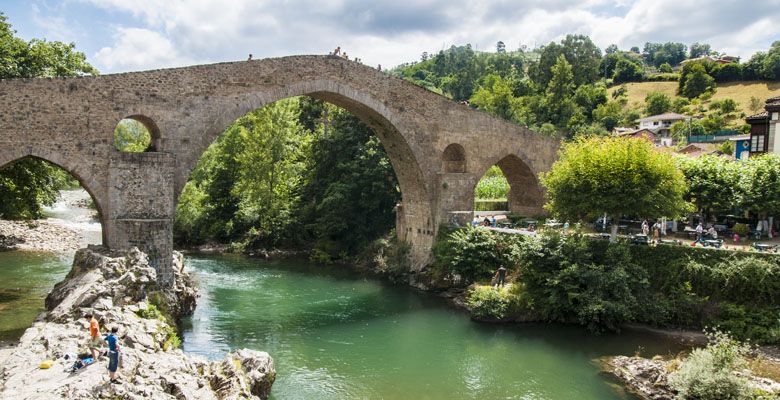
Dejamos atrás esta joya del s. XIII, declarada Monumento Histórico Artístico en 1.931, para desviarnos por la N-625 hacia el concejo de Amieva. Desde la localidad de Sames, ascenderemos hasta el mirador de la Collada. Situado a 800 metros de altitud, desde él obtendremos unas magníficas vistas de los Picos de Europa y el valle de Angón, en un ambiente impregnado de silencio que sólo podrá enturbiarse por el motor de algún tractor en plena faena o el tintineo de los cencerros del ganado.
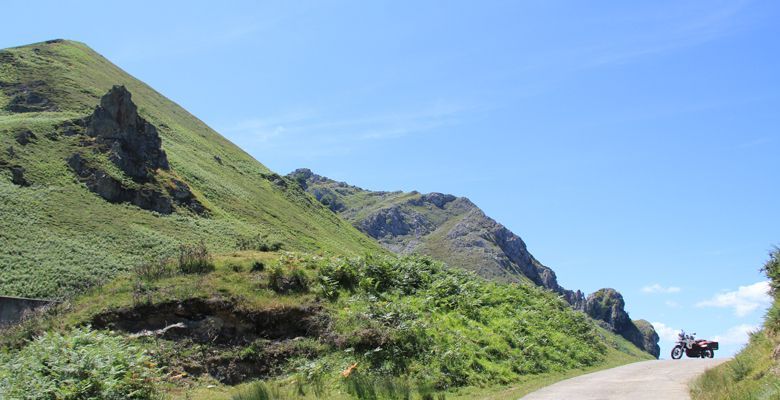
El pueblo de Amieva, empequeñecido por la perspectiva que se obtiene desde aquí, nos brinda la posibilidad de engrandecer aún más el entorno que nos rodea.
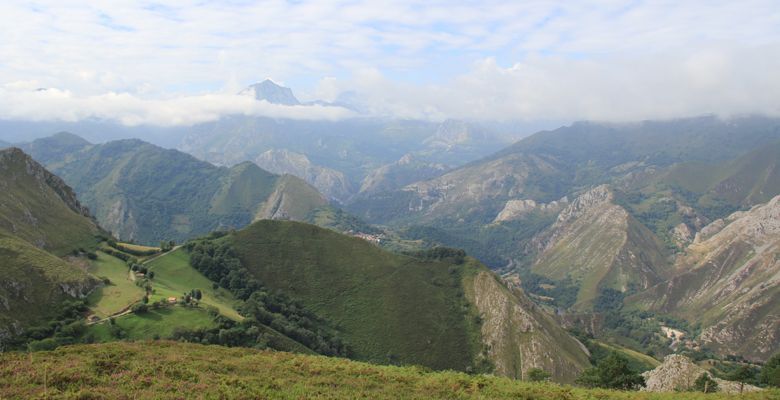
Si volvemos sobre nuestras rodadas, poco después de salir de Cangas de Onís, por la CO-2, accederemos a Següenco. En este punto, aquellos motoristas que no sean perezosos podrán bajarse de sus monturas y recorrer el kilómetro escaso que resta hasta el mirador. Desde allí, se nos abre de nuevo una ventana al paraíso asturiano desde la que contemplar: Covadonga, Picos de Europa, el Sueve... Sin duda, ¡merece la pena acercarse! Nos iremos con la sensación de haber estado en uno de los miradores menos conocidos de Asturias pero, no por ello menos espectacular.
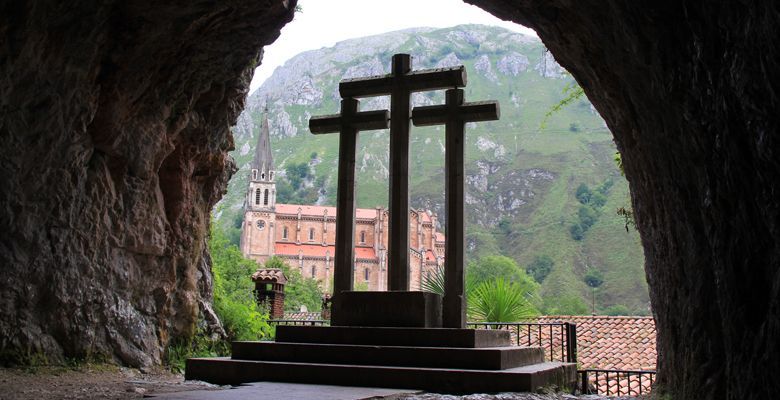
En este viaje no puede faltar la visita a la Basílica de Covadonga, a la Santa Cueva y a los Lagos. Lugares que gozan de por sí de gran popularidad hasta el punto de ser necesaria la regulación del tráfico rodado en determinadas épocas del año (por ello, es preciso informarse antes de emprender ruta).
Estamos en un paraje idílico que, por su orografía, fue el escenario perfecto para una batalla crucial: la de Covadonga. Aquí nos olvidaremos del reloj y simplemente, junto a la estatua de Pelayo, retrocederemos en el tiempo a los años de la Reconquista para después rendir culto a la que es la patrona de Asturias, la Virgen de Covadonga, conocida popularmente como La Santina. Las lectoras en edad casadera han de saber que cuenta una leyenda popular que “la Virgen de Covadonga tiene una fuente muy clara, la niña que de ella bebe, dentro del año se casa”. Así que, si alguna tiene interés, ya sabe que la conocida como “fuente de los 7 caños” es parada obligada en esta ocasión.
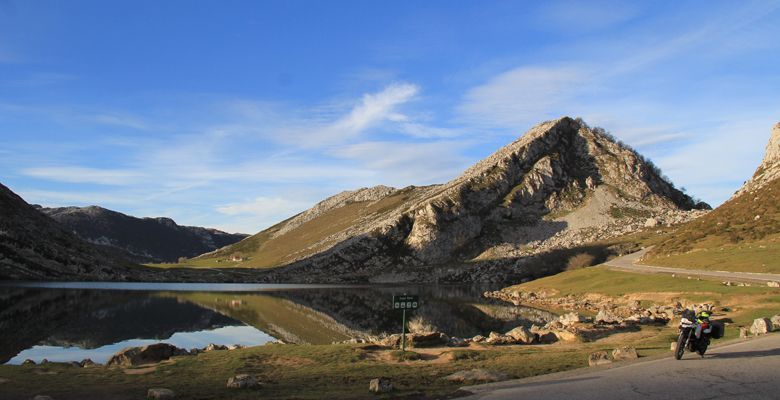
La visita se completa con la popular subida a Los Lagos (fuera de las épocas de restricción, que podéis consultar aquí). Doce kilómetros de curvas, escenarios inimaginables y, de nuevo, miradores. El primero, el mirador de La Reina y, en lo alto, dando vistas a ambos lagos – Enol y Ercina -, el mirador de Entrelagos. La vera de cualquiera de sus dos lagos, rodeados de cientos de cabezas de ganado que campan a sus anchas por los prados, son, sin duda, un buen lugar para tomar un refrigerio y admirar, de nuevo, la belleza de los Picos de Europa en una estampa que parece sacada de un cuento.
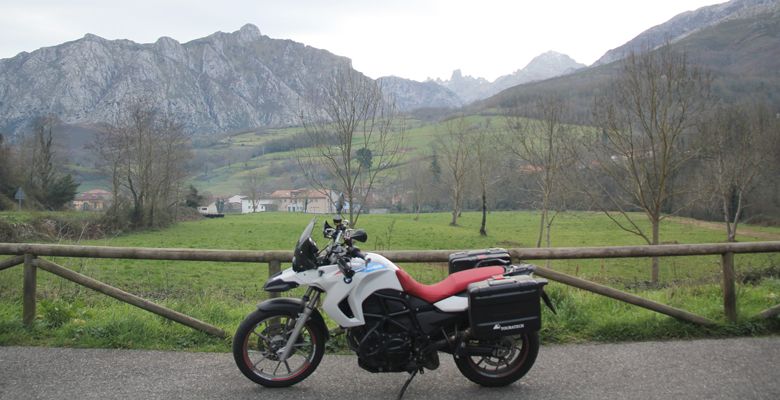
Proseguimos ruta en dirección Cabrales, por el Alto del Ortiguero, pasado Carreña de Cabrales llegaremos a un amplio aparcamiento con otro mirador mítico: el del Pozo de la Oración. En días despejados, el Urriellu, o Naranjo de Bulnes, brillará coqueteando con nosotros, enseñándonos una silueta inconfundible para cualquier asturiano. De vuelta en Carreña, sólo tendremos que seguir las indicaciones hacia el pueblo de Asiego para llegar hasta otro punto de interés de nuestro viaje: el mirador de Pedro Udaondo ¡Una vez más, el Macizo Central de Picos de Europa en todo su esplendor! Recibió este nombre como homenaje póstumo del pueblo de Cabrales a una de las leyendas del alpinismo en Picos.
Continuamos este periplo por los Picos de Europa en Arenas de Cabrales, donde cogeremos el desvío que nos conduce a Poncebos, punto de inicio de la ruta del Cares. Desde esta localidad, ascenderemos hasta el pequeño pueblo de Camarmeña, una empinada subida plagada de pronunciadas, y continuas, curvas de herradura que en poco más de un kilómetro nos conduce hasta un mirador alineado con la canal del Tejo, por la que discurre la senda que sube a Bulnes, única ruta de acceso hasta la inauguración del funicular. Un rato contemplando este paraje nos hará sentirnos como ´liliputienses´ ante las magnas obras de la Naturaleza.
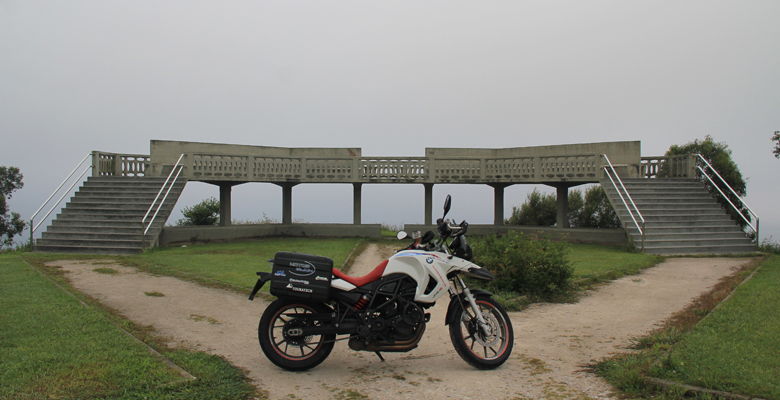
Como colofón, saldremos en busca de la costa para alcanzar el mirador del Picu, en Pimiango, a medio camino hacia la Cueva del Pindal, la cual conserva uno de los conjuntos de arte parietal más importante de Asturias enclavada en una zona de gran valor cultural y natural. Desde este mirador podremos escoger hacia dónde dirigir nuestras miradas, si bien hacia un lado se encuentra la inimitable costa asturiana, hacia el otro podremos divisar el contorno de los Picos de Europa, ese que llevamos acariciando durante prácticamente todo nuestro viaje.
Ya para finalizar, concluiremos esta ruta con un paseo por Colombres, elegido Pueblo Ejemplar en el año 2.015, donde queda patente, a través de la arquitectura, la huella indiana. Así nos encontramos con algunas casas palaciegas como La Solana o La Quinta Guadalupe, hoy sede del Archivo de Indianos, cuyas puertas atravesaremos para sumergirnos en una parte crucial de la historia asturiana.
190 kilómetros plagados de naturaleza donde sentiremos la magia y atracción del oriente de Asturias a través de una serie de miradores que se convertirán en nuestro vínculo de unión con todo un símbolo en el Principado: el Parque Nacional de los Picos de Europa.
Texto y fotos: Sonia Barbosa Silva
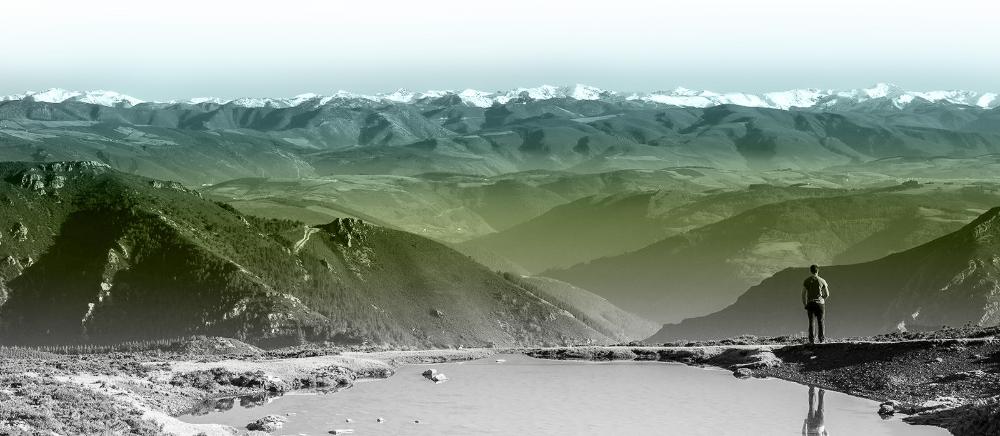
Suscríbete a nuestra newsletter y aprovéchate de ofertas, descuentos, y novedades
Suscribirse
